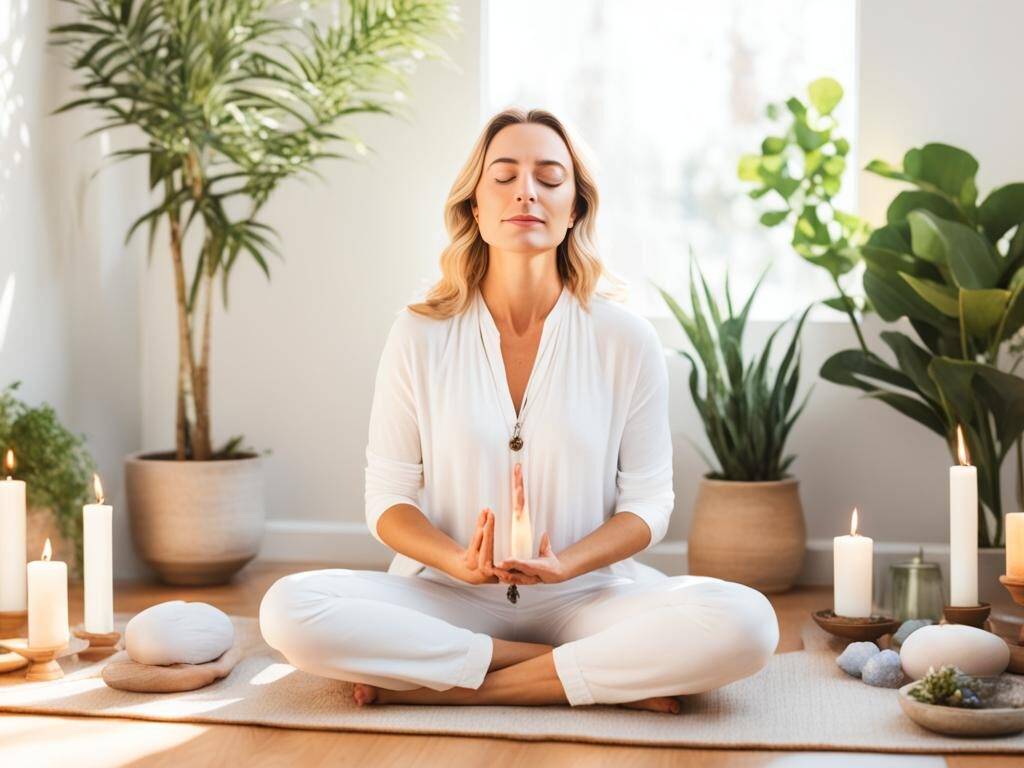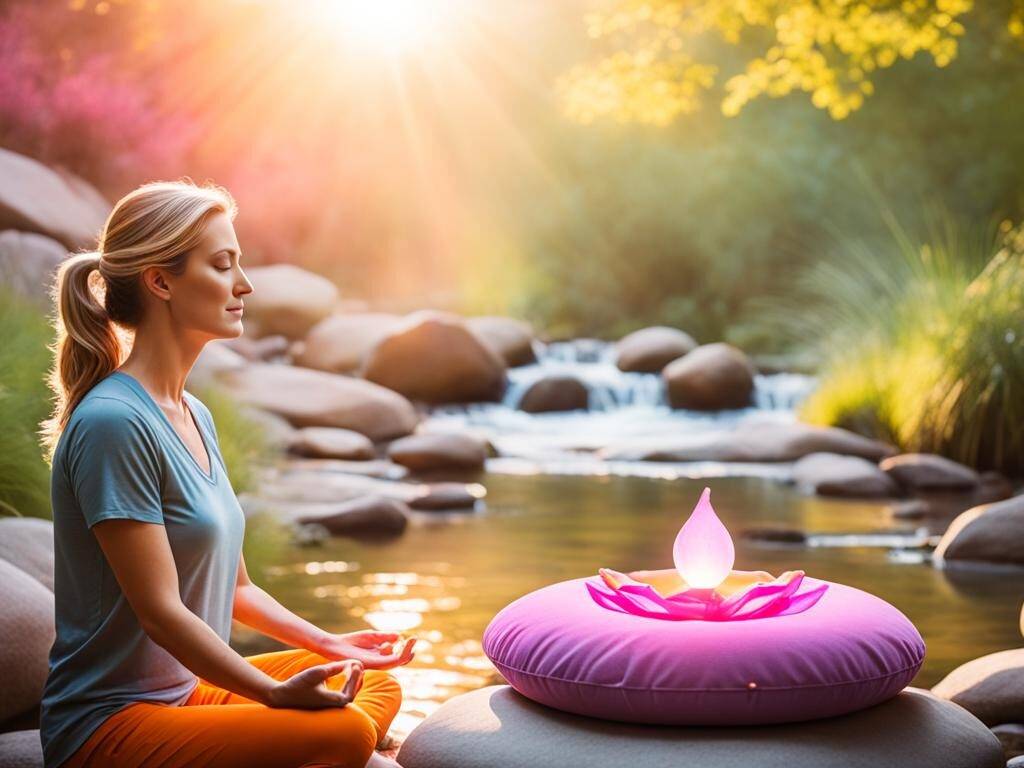Welcome to our beginner’s guide to starting a daily meditation practice! If you’re new to meditation and looking for a way to enhance your overall well-being and reduce stress, you’ve come to the right place. In this guide, we will walk you through the basics of meditation and provide you with practical tips to help you establish a consistent daily practice.
Meditation is an ancient practice that has gained popularity in recent years for its numerous health benefits. It involves training the mind to focus and redirect thoughts, allowing for a calm and clear state of mind. While meditation may seem daunting for beginners, it is actually quite accessible and can be easily incorporated into your daily routine.
In the following sections, we will cover everything you need to know to get started with meditation. From understanding different meditation techniques and creating a dedicated space for your practice, to setting realistic goals and overcoming common challenges, we will guide you every step of the way.
Whether you have a specific reason for wanting to start a daily meditation practice or simply want to explore the benefits of mindfulness, we are here to support you on your journey. So, let’s dive in and discover the transformative power of meditation!
Key Takeaways:
- Starting a daily meditation practice can have numerous benefits for your overall well-being.
- Meditation is a practice that involves training the mind to focus and redirect thoughts.
- Creating a dedicated space for meditation and setting realistic goals are important for beginners.
- Consistency and patience are key to cultivating a daily meditation habit.
- Guided meditations can be helpful for beginners who prefer external guidance.
Understanding Meditation
When starting a meditation practice, it’s important to have a clear understanding of what meditation is and the various techniques available, especially for beginners. Meditation is a practice that involves training the mind to focus and redirect its thoughts. Through regular meditation, individuals can achieve a state of deep relaxation and heightened awareness.
Mindfulness is a key aspect of meditation practice. It involves bringing one’s attention to the present moment and observing thoughts, feelings, and sensations without judgment. Mindfulness helps cultivate a greater sense of self-awareness and enables individuals to be fully present in their daily lives.
There are several meditation techniques that are suitable for beginners, each offering unique benefits and approaches. Here are some popular techniques:
- Guided Meditation: This technique involves listening to a recorded meditation or following along with a meditation app. Guided meditations provide step-by-step instructions and can be helpful for beginners who prefer external guidance.
- Body Scan: The body scan technique involves systematically focusing attention on different parts of the body, starting from the toes and moving up to the head. It helps to develop a deep connection between the mind and body.
- Mantra Meditation: Mantra meditation involves repeating a word or phrase, known as a mantra, silently or aloud. This technique can help quiet the mind and enhance concentration.
- Breathing Meditation: Focusing on the breath is a common and accessible meditation technique. By observing the breath, beginners can learn to cultivate a sense of calm and relaxation.
It’s important to remember that there is no right or wrong way to meditate. The key is to find a technique that resonates with you and aligns with your goals and preferences. Experimenting with different techniques can help you discover what works best for you.

Understanding meditation techniques and the concept of mindfulness is essential for beginners embarking on their meditation journey. In the next section, we will explore the significance of creating a sacred space for meditation and how it can enhance your practice.
Creating a Sacred Space
When starting a daily meditation practice, it’s essential to create a dedicated space where you can find peace and tranquility. A sacred space can help you establish a sense of calm and focus, allowing you to fully immerse yourself in your meditation practice.
Here are some tips on how to set up a calm and peaceful environment for your meditation:
- Find a quiet area: Choose a location in your home that is free from distractions and noise. It could be a spare room, a corner in your bedroom, or even a peaceful spot in your garden.
- Clear the clutter: Remove any unnecessary items from your meditation space to create a clean and uncluttered area. A tidy space helps to clear your mind and promotes a sense of tranquility.
- Bring in natural elements: Incorporate natural elements into your sacred space, such as plants, flowers, or crystals. These elements can help create a connection with nature and enhance the calming atmosphere.
- Set the ambiance: Use soft lighting or candles to create a calming ambiance in your meditation space. Dimmed lights can help relax your mind and prepare you for meditation.
- Add comfortable seating: Choose a comfortable cushion or chair to sit on during your meditation practice. It’s essential to have proper support to maintain good posture and avoid discomfort.
Creating a sacred space for your meditation practice signifies the importance you place on taking time for yourself. It’s a physical representation of your commitment to your daily meditation routine.
Remember, your sacred space doesn’t need to be elaborate or large. What matters is that it feels conducive to calmness and introspection. Personalize it with items that have significance to you, such as meaningful objects or photographs.

Having a designated space for meditation can help signal to your mind and body that it’s time to enter a state of relaxation and focus. As you consistently practice meditation in this space, the environment itself will become associated with a sense of calm, making it easier for you to enter a meditative state.
Setting Realistic Goals
When starting a meditation practice, it’s important to set realistic goals that align with your daily routine and lifestyle. Establishing achievable expectations will help you stay motivated and committed to your meditation practice. Here are some tips to guide you in setting realistic goals:
- Start small: Begin with short meditation sessions, such as 5 or 10 minutes, and gradually increase the duration as you become more comfortable.
- Be consistent: Aim to meditate daily, even if it’s just for a few minutes. Consistency is key in developing a daily meditation routine.
- Focus on progress: Instead of striving for perfection, focus on the progress you make over time. Celebrate each milestone as you develop your meditation practice.
- Set intention: Clarify your intention for practicing meditation. Whether it’s to reduce stress, improve focus, or cultivate inner peace, having a clear intention will help you stay motivated.
- Track your progress: Keep a meditation journal to track your daily practice. Note the duration, any insights or experiences, and how you felt before and after each meditation session.
Remember, the journey of meditation is personal, and everyone progresses at their own pace. Instead of comparing yourself to others, focus on your own growth and the positive impact meditation has on your well-being.
“Setting goals is the first step in turning the invisible into the visible.” – Tony Robbins
The Benefits of Tracking Your Meditation Practice
Tracking your meditation practice allows you to observe and reflect on your progress. It provides a way to monitor your consistency and identify patterns in your meditation routine. Moreover, tracking allows you to assess the impact of meditation on your overall well-being. Use the table below to track your meditation practice:
| Date | Duration | Feelings |
|---|---|---|
| May 1, 2022 | 10 minutes | Relaxed and focused |
| May 2, 2022 | 15 minutes | Restless, but felt a sense of calm afterward |
| May 3, 2022 | 5 minutes | Distracted, struggled to focus |
| May 4, 2022 | 10 minutes | Peaceful and centered |

By tracking your meditation practice, you can identify trends in your experience and adjust your goals accordingly. Whether it’s increasing the duration, focusing on specific feelings or concerns, or exploring different techniques, the insights gained from tracking can guide the evolution of your meditation practice.
Finding the Right Time
When it comes to starting a daily meditation practice, timing plays a crucial role. The right time of day can greatly impact your experience and effectiveness in meditation. In this section, we will explore different times of the day that are most conducive to meditation practice. We will discuss the benefits of morning versus evening meditation and help you determine what works best for you.
The Morning Advantage:
Meditating in the morning has its own unique advantages. Starting your day with meditation helps set a positive tone and intention for the rest of the day. It allows you to center yourself, cultivate mindfulness, and bring a calm and focused mindset to your activities. Morning meditation can provide a sense of clarity, mental alertness, and increased energy throughout the day.
The Evening Calm:
On the other hand, many people find that meditating in the evening is a valuable way to unwind, relax, and release the stress and tension accumulated throughout the day. Evening meditation can help you let go of any worries or anxieties, promoting a sense of peace and tranquility before heading to bed. It can also improve the quality of your sleep and help you wake up feeling refreshed.
| Morning Meditation | Evening Meditation |
|---|---|
| Clears the mind for a focused day ahead | Helps relax and release accumulated stress |
| Increases mental alertness and energy | Promotes better sleep quality |
| Fosters a positive and mindful mindset | Creates a sense of calm and tranquility |
Ultimately, the best time for meditation is the time that fits well with your daily routine and personal preferences. Some individuals may find that a combination of morning and evening sessions works best for them, allowing for a balanced approach throughout the day. Experiment with different times and observe how it affects your overall well-being and meditation experience.
Next, we’ll delve into the importance of cultivating the habit of daily meditation. Creating a consistent routine is key to reaping the benefits of this practice for both mind and body.

Cultivating the Habit
Consistency is key when starting a daily meditation practice. Establishing a regular routine will help you integrate meditation into your daily life and experience its long-term benefits. Here are some practical tips to help you cultivate the habit of daily meditation:
- Set aside a specific time for meditation each day. It could be in the morning, before bed, or during a quiet moment in your day. By dedicating a specific time to your practice, you create a structure that makes it easier to prioritize meditation.
- Create a dedicated meditation space. Find a quiet and comfortable area where you can sit or lie down without distractions. You can decorate this space with objects that inspire peace and tranquility.
- Start with shorter sessions. When beginning your meditation practice, it’s important to build up gradually. Start with sessions as short as 5-10 minutes and gradually increase the duration over time.
- Use reminders. Set up alarms or notifications on your phone or use a meditation app that sends reminders throughout the day. These reminders will help you stay committed to your practice.
- Find an accountability partner or join a meditation group. Sharing your meditation journey with others can provide motivation and support. Consider joining local meditation groups or connecting with like-minded individuals online.
- Experiment with different meditation techniques. There are various meditation techniques to explore, such as mindfulness meditation, loving-kindness meditation, or guided visualizations. Try different approaches to find what resonates with you.
- Be kind to yourself. Remember, meditation is a practice, and it’s natural to have ups and downs. Don’t judge yourself harshly if your mind wanders or if you miss a day. Treat yourself with compassion and continue to show up for your practice.
By incorporating these strategies into your daily life, you’ll create a solid foundation for your daily meditation routine and gradually make it an integral part of your day.

Remember, consistency is key to reaping the full benefits of meditation. Develop a habit that feels sustainable, and be patient with yourself as you embark on this transformative journey.
Practicing Breathing Techniques
Breathing techniques are a fundamental aspect of meditation practice, especially for beginners. By focusing on the breath, you can calm your mind, increase mindfulness, and deepen your meditation experience. In this section, we will introduce various breathing exercises that are suitable for beginners.
1. Diaphragmatic Breathing: Also known as deep belly breathing, diaphragmatic breathing involves inhaling deeply through your nose, allowing your abdomen to expand fully. As you exhale through your nose, feel your abdomen contract. This technique helps activate the relaxation response and promotes deep relaxation.
2. Counting Breaths: To practice this technique, choose a quiet and comfortable space. Close your eyes and take a deep breath in through your nose. As you exhale, count “one” silently. Inhale again and count “two” on the exhale. Continue this pattern, counting up to ten breaths. If your mind wanders, gently bring your focus back to the breath and restart the count.
3. Box Breathing: Box breathing is a technique that involves inhaling, holding your breath, exhaling, and holding your breath again. Imagine tracing a square with your breath, inhaling for a count of four, holding for a count of four, exhaling for a count of four, and then holding for another count of four. This technique helps promote calmness and mental clarity.
“The breath is the bridge between body and mind.” – Thich Nhat Hanh
Remember, as a beginner, it is natural for your mind to wander during meditation. When this happens, gently bring your attention back to the breath. Consistency is key, so try to incorporate these breathing techniques into your daily meditation routine.

Benefits of Breathing Techniques:
- Reduces stress and anxiety levels
- Improves focus and concentration
- Promotes relaxation and a sense of calm
- Enhances self-awareness and mindfulness
- Regulates emotions and promotes emotional well-being
By practicing these easy meditation techniques for beginners, you can harness the power of your breath to create a peaceful and centered state of mind. Take a deep breath in, and let your meditation journey begin.
Dealing with Distractions
Distractions can often hinder your meditation practice, especially if you are just starting out. The mind tends to wander, and external factors can easily steal your focus. But fear not, there are practical strategies to overcome distractions and stay centered during meditation.
1. Create a Quiet Environment
Find a quiet place where you can meditate without interruptions. Turn off your phone or put it on silent mode to minimize distractions. Creating a peaceful and serene environment will help calm your mind and enhance your meditation experience.
2. Set Clear Intentions
Before you start your meditation session, set clear intentions for your practice. Remind yourself why you are meditating and what you hope to achieve. These intentions will act as anchors and help you refocus when distractions arise.
3. Embrace the Present Moment
One of the key concepts in meditation is mindfulness, which involves being fully present in the current moment. When distractions arise, gently bring your attention back to the present moment. Notice the sensations in your body, your breath, or the sounds around you. By cultivating mindfulness, you can train your mind to stay focused.
4. Observe Distractions Non-Judgmentally
Instead of resisting or getting frustrated with distractions, try observing them without judgment. Treat distractions as passing thoughts or sensations, allowing them to come and go. By observing distractions non-judgmentally, you create a space for them to naturally fade away.
5. Use Anchors of Focus
Anchors of focus, such as the breath or a mantra, can help divert your attention from distractions. Choose a specific anchor and use it as your point of focus throughout your meditation. Whenever distractions arise, gently bring your attention back to the anchor.
“The mind is naturally restless, so don’t be disheartened by distractions. Simply acknowledge them and gently guide your focus back to the present moment.” – Jon Kabat-Zinn
Remember, dealing with distractions is part of the meditation journey, especially for beginners. Be patient with yourself and practice consistently. As you continue to meditate, you will develop greater inner calmness and the ability to stay focused amidst distractions.

Exploring Guided Meditations
For beginners who prefer external guidance, guided meditations can be a valuable tool in starting a meditation practice. These guided meditations provide step-by-step instructions and soothing narratives that help ease you into a meditative state.
One of the benefits of using guided meditation apps or recordings is the accessibility and variety they offer. You can choose from a wide range of themes, such as relaxation, stress relief, or mindfulness, allowing you to tailor your practice to your specific needs.
Guided meditations are also helpful for those who find it challenging to quiet their minds or stay focused during meditation. The soothing voice of the guide can help keep your attention anchored, making it easier to stay present and engaged in the practice.
When exploring guided meditations, consider using popular meditation apps like Headspace, Calm, or Insight Timer. These apps provide a vast library of guided meditations that cater to beginners, making it easier to find one that resonates with you.
Benefits of Guided Meditations:
- External guidance for beginners
- Step-by-step instructions to ease you into meditation
- Variety of themes to choose from
- Helps with quieting the mind and staying focused
- Accessible through meditation apps
Remember, guided meditations are a tool to support your meditation practice, but it’s essential to gradually transition to self-guided meditation as you become more comfortable. It’s an opportunity for you to develop your own meditation skills and deepen your connection with yourself.

| Popular Meditation Apps for Guided Meditations | Features |
|---|---|
| Headspace |
|
| Calm |
|
| Insight Timer |
|
Overcoming Challenges
Starting a daily meditation practice can be a transformative journey, but it’s not without its challenges. As a beginner, you may encounter obstacles that make it difficult to stay consistent and motivated. However, with the right strategies and mindset, you can overcome these challenges and establish a fulfilling meditation practice.
1. Embrace Imperfection
One common challenge for beginners is the pressure to achieve a perfect meditation session every time. It’s essential to remember that meditation is a practice, and like any practice, it takes time to improve. Embrace imperfection and let go of expectations. Allow yourself to have moments of distraction or restlessness without judgment. Remember, the goal is not to eliminate thoughts completely, but to observe them without attachment and return to your point of focus.
2. Find Your Motivation
Maintaining motivation is crucial for building a sustainable meditation practice. Take some time to reflect on why you want to meditate and how it can positively impact your life. Whether it’s reducing stress, improving focus, or enhancing overall well-being, having a clear purpose will help you stay committed even on challenging days. Write down your motivations and revisit them whenever you need a reminder.
3. Start Small and Build Gradually
Many beginners struggle with establishing a consistent meditation routine. It’s essential to start small and gradually increase the duration of your practice. Begin with just a few minutes each day and gradually add more time as you become comfortable. By starting small, you’ll build the habit without overwhelming yourself. Consistency is more important than duration in the early stages.
4. Seek Support and Guidance
Don’t hesitate to seek support and guidance when facing challenges in your meditation practice. Joining a meditation group, participating in a class, or finding an experienced teacher or mentor can provide valuable insights and encouragement. Surrounding yourself with like-minded individuals who share a similar journey can make a significant difference in staying motivated and overcoming obstacles.
5. Stay Flexible
Resistance is a common challenge that can arise when establishing a daily meditation practice. There may be days when you don’t feel like meditating or when unexpected events disrupt your routine. It’s crucial to stay flexible and adapt to these situations without self-judgment. If you can’t stick to your usual meditation time, find alternative moments during the day to squeeze in a shorter session. Remember, even a few minutes of meditation can make a difference.
By acknowledging and addressing the challenges that may arise, you can navigate the path of starting a meditation practice with greater ease. Remember to be gentle with yourself, celebrate small victories, and stay committed to your growth. Overcoming these challenges will lead to a fulfilling and transformative meditation practice.

Expanding Your Practice
Once you have established a regular daily meditation routine, you may find yourself ready to take your practice to the next level. Exploring different techniques and deepening your meditation experience can help you continue your journey as a meditator and unlock new levels of clarity, peace, and self-awareness.
Try Different Meditation Techniques
Diversifying your meditation practice allows you to tap into various approaches and find what resonates with you on a deeper level. Experiment with different techniques such as:
- Guided meditation: Utilizing guided meditation recordings or apps can provide structure and guidance as you explore different themes or cultivate specific qualities like loving-kindness or gratitude. This is a great way for beginners to enhance their practice and deepen their understanding of meditation.
- Mantra meditation: Chanting or silently repeating a mantra can help focus the mind and foster a sense of tranquility. Choose a mantra that holds personal significance, such as “Om” or “peace,” and incorporate it into your meditation sessions.
- Walking meditation: If sitting still for long periods feels challenging, try walking meditation. This practice involves bringing mindfulness to each step, paying attention to the sensations in your feet and body as you move.
By trying different techniques, you can explore various aspects of meditation and gain a broader perspective on your practice.
Deepen Your Mindfulness Practice
Mindfulness is a key element of meditation and can be cultivated both on and off the cushion. Here are some ways to deepen your mindfulness practice:
- Extend mindfulness to daily activities: Bring a heightened state of awareness and presence to everyday tasks such as eating, showering, or cleaning. Pay attention to the sensations, smells, and tastes, immersing yourself fully in the present moment.
- Integrate mindfulness into relationships: Practice mindful listening and empathetic communication with loved ones. By being fully present and attentive, you can foster deeper connections and improve the quality of your relationships.
- Attend meditation retreats: Consider joining a meditation retreat to immerse yourself in a dedicated period of practice. Retreats offer a supportive environment to deepen your practice, learn from experienced teachers, and connect with a community of like-minded individuals.
Deepening your mindfulness practice extends the benefits of meditation into your daily life, enhancing your overall well-being and presence.
Continue Learning and Growing
As a beginner meditator, there is always room for growth and expansion in your practice. Explore meditation literature, attend workshops or webinars, and seek guidance from experienced meditators or teachers. Engaging in ongoing learning will deepen your understanding of different meditation traditions, provide new insights, and inspire you to maintain a lifelong meditation journey.
Remember, meditation is a personal and individual practice, so it’s essential to find what works best for you. Embrace the opportunity to explore, experiment, and make your meditation practice a reflection of your unique journey.

Conclusion
Throughout this article, we have explored the essential aspects of starting a daily meditation practice for beginners. We have discussed the benefits of meditation and the various techniques that can be used to cultivate mindfulness.
It is important to remember that starting a meditation practice requires persistence and patience. Setting realistic goals and finding the right time for your practice are key to establishing a routine. Creating a dedicated space and using breathing techniques can enhance your meditation experience.
As you embark on this journey of self-discovery and self-care, it is normal to encounter distractions and challenges along the way. However, with consistency and the right strategies, you can overcome these obstacles and deepen your practice.
Remember, meditation is not a destination but a lifelong journey. Embrace it with an open mind and allow yourself to experience its transformative power. Whether you are seeking inner peace, stress relief, or personal growth, meditation has the potential to positively impact every aspect of your life.

